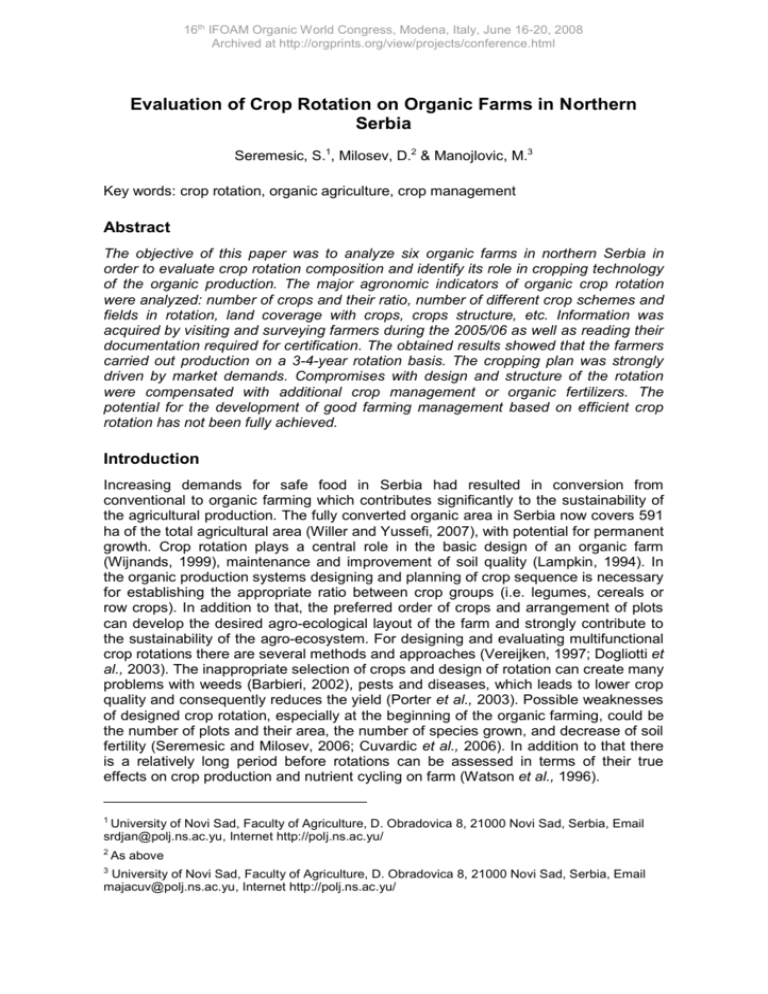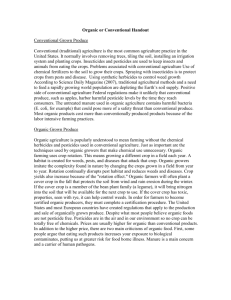Evaluation of Crop Rotation on Organic Farms in Northern Serbia
advertisement

16th IFOAM Organic World Congress, Modena, Italy, June 16-20, 2008 Archived at http://orgprints.org/view/projects/conference.html Evaluation of Crop Rotation on Organic Farms in Northern Serbia Seremesic, S.1, Milosev, D.2 & Manojlovic, M.3 Key words: crop rotation, organic agriculture, crop management Abstract The objective of this paper was to analyze six organic farms in northern Serbia in order to evaluate crop rotation composition and identify its role in cropping technology of the organic production. The major agronomic indicators of organic crop rotation were analyzed: number of crops and their ratio, number of different crop schemes and fields in rotation, land coverage with crops, crops structure, etc. Information was acquired by visiting and surveying farmers during the 2005/06 as well as reading their documentation required for certification. The obtained results showed that the farmers carried out production on a 3-4-year rotation basis. The cropping plan was strongly driven by market demands. Compromises with design and structure of the rotation were compensated with additional crop management or organic fertilizers. The potential for the development of good farming management based on efficient crop rotation has not been fully achieved. Introduction Increasing demands for safe food in Serbia had resulted in conversion from conventional to organic farming which contributes significantly to the sustainability of the agricultural production. The fully converted organic area in Serbia now covers 591 ha of the total agricultural area (Willer and Yussefi, 2007), with potential for permanent growth. Crop rotation plays a central role in the basic design of an organic farm (Wijnands, 1999), maintenance and improvement of soil quality (Lampkin, 1994). In the organic production systems designing and planning of crop sequence is necessary for establishing the appropriate ratio between crop groups (i.e. legumes, cereals or row crops). In addition to that, the preferred order of crops and arrangement of plots can develop the desired agro-ecological layout of the farm and strongly contribute to the sustainability of the agro-ecosystem. For designing and evaluating multifunctional crop rotations there are several methods and approaches (Vereijken, 1997; Dogliotti et al., 2003). The inappropriate selection of crops and design of rotation can create many problems with weeds (Barbieri, 2002), pests and diseases, which leads to lower crop quality and consequently reduces the yield (Porter et al., 2003). Possible weaknesses of designed crop rotation, especially at the beginning of the organic farming, could be the number of plots and their area, the number of species grown, and decrease of soil fertility (Seremesic and Milosev, 2006; Cuvardic et al., 2006). In addition to that there is a relatively long period before rotations can be assessed in terms of their true effects on crop production and nutrient cycling on farm (Watson et al., 1996). 1 University of Novi Sad, Faculty of Agriculture, D. Obradovica 8, 21000 Novi Sad, Serbia, Email srdjan@polj.ns.ac.yu, Internet http://polj.ns.ac.yu/ 2 3 As above University of Novi Sad, Faculty of Agriculture, D. Obradovica 8, 21000 Novi Sad, Serbia, Email majacuv@polj.ns.ac.yu, Internet http://polj.ns.ac.yu/ 16th IFOAM Organic World Congress, Modena, Italy, June 16-20, 2008 Archived at http://orgprints.org/view/projects/conference.html The aim of this study was to evaluate crop rotation composition at six organic farms in order to improve utilization of farm resources and management practice. Materials and methods The following farms were analyzed: Kelebija, Tavankut, Ljutovo, Bajmok, Kisac and Orom. Selected farms were recommended for study after discussion with certification organisation in Serbia and therefore we consider them eligible according to national organic standard. Among them there were no common treatments. The information about cropping practice was obtained from questionnaires, farm documents (prepared for the certification), and by interviewing the farmers in investigation conducted 2005/06. Numerical data were presented as average values for two production year after statistical analyses, whereas indicators of crop rotation were expressed by proper mark. Soil chemical analyses indicated that the certified organic sites were either as fertile as the adjacent conventional fields or marginally less fertile but not significantly so (Cuvardic et al., 2006). Soil fertility was maintained, primarily, with different amounts of an organic fertilizer (i.e. manure, compost) applied at four-year intervals on each field and microbiological fertilizers (i.e. Bactofil A and B, Humisin, Bioactive etc.). Selected farmers utilized on-farms resources for additional nutrient input such as N-fixing crops (i.e. soybean, pea) and green manures (Trifolium sp., Medicago sativa, Phacelia tanacetifolia etc.). Primary tillage was conducted with shallow mouldboard ploughing or disc harrowing in autumn, and seedbed preparation was carried out with harrow, disk harrow and field cultivators. Results Organic farming at the observed sites was combined crop-livestock production fitted to specific agro-ecological condition. However, animal husbandry is not as important as arable production. We found that each farm is an independent production unit, strongly subjected to the dominant constraint of the production area. The number of the species grown at the organic farms was significantly different (Tab. 1, Tab. 2). As good preceding crops, cereals shared 21.4-25.8% of the total arable area of examined farms (except for Tavankut). The high proportion of cereals and legumes, necessary for the composition of a balanced crop rotation, was found on Ljutovo and Orom. Different from this, organic producers at Kelebija and Bajmok grew > 50% row crops and may have difficulties in achieving optimal rotation design. The Kisac farm was vegetable-oriented with more than 30 different varieties of vegetables and >60% of arable land covered with vegetables indicating that this production is orientated to fresh markets with labour intensive management and high production costs. Tab. 1: Crop structure on the examined organic farms ORGANIC FARMS Total Arable area (ha) CROP STRUCTURE KELEBIJA TAVANKUT LJUTOVO BAJMOK KISAC OROM 11.7 5 15,5 11.9 14 6.5 Crops Area Crops Area Crops Area Crops Area Crops Area Crops Area (%) (ha) (%) (ha) (%) (ha) (%) (ha) (%) (ha) (%) (ha) Legumes (annual/perennial) 11.1 1.3 40 2 37.4 5.8 13.4 1.6 7.1 1 53.8 3.5 Cereals (winter/spring) 24.8 2.9 - - 25.8 4 25.2 3 21.4 3 23.1 1.5 Roots and tuber plant 1.7 0.2 - - 1.9 0.3 - - 14.2 2 - - Vegetable 11.1 1.3 - - 15.5 2,4 - - 64.3 9 - - Row crops 51.3 6.0 60 3 19.4 3 61.4 7.3 - - 23.1 1.5 16th IFOAM Organic World Congress, Modena, Italy, June 16-20, 2008 Archived at http://orgprints.org/view/projects/conference.html On the Tavankut farm, there were only two fields in the certified production (alfalfa (third year) and oil pumpkin), established at the beginning of the certified production after soybean and wheat as preceding crops. Tab. 2: Crop structure on the examined organic farms CROP GROUPS Kelebija Tavankut ORGANIC FARMS Ljutovo Bajmok Kisac Orom Legumes 2 1 3 2 1 1 Cereals (winter/spring) 2 - 4 2 1 1 Roots and tuber plant 1 - 2 - 1 - Vegetable 5 - 1 - 11 - Row crops 3 1 3 2 - 1 Total number of crops 13 2 13 6 14 3 Discussion After conversion from conventional agriculture organic producers continue growing same crops. Arable organic systems at the organic farms showed a tendency toward development in two directions, one being the improvement of soil quality with more N 2fixing crops and lower economic value and the other more N demanding cash crops. As for the number of grown crops (except for Tavankut) and field allocation (Tab. 1) there were many possibilities for different rotations, especially mixed ones with row crops, cereals, vegetables and forage crops. Organic production on the examined farms was based generally on a 3-4 crops in rotation with a tendency for proper alternation of different crop groups (legumes/cereals/row crops/vegetables). However selection of appropriate crop (among desired crop group) was limited only to one year ahead, compatible with rotation design, proportion of crop groups, and agroecosystem resources (Tab. 2). Consequently, this approach generally resulted in “loose” rotation, where specific, apparently important crops for farmers can be overrepresented in the rotation and grown too intensively (Wijnands, 1999). The desired level for soil cover index (SCI) is to have crops covering the soil for more than 80% of the year (Helander and Delin, 2004). In our study soil cover index varies (5590%). We found that SCI for the observed period averages at 70% (8 ½ months), which should be improved. Only two out of six farmers regularly included winter cover crops and planted second crop into a main crop to improve efficiency of the cropping design and biodiversity. Tab. 3: Agronomic evaluation of crop rotations INDICATORS Type of rotation1 Intercropping Winter cover crops Number of crops in rotation SCI2(%) Rotation planning3 1 ORGANIC FARMS Kelebija Tavankut Ljutovo Bajmok Kisac Orom V/FCV Yes No 4-5 70% 1 L No No 3 75% 1 FCV Yes Yes 3-4 65% 2 FCV No No 4 65% 1 V No Yes 4 90% 1 FCV No No 3-4 55% 1 Types of crops that were the subject of planned rotation (other crops were grown in other fields on the farm); V- vegetable crops, FC- field crops, L-legumes; 2Soil Cover Index-period of year during which the soil is covered with plants (% of 12 month) - estimated by farmers; 3Number of years of planned crop rotation in the future. 16th IFOAM Organic World Congress, Modena, Italy, June 16-20, 2008 Archived at http://orgprints.org/view/projects/conference.html Based on the observed crop rotation indicators and farm resources crop rotations should be more efficient in resources utilization and less dependant on market conditions. With clear goals of the organic production farmer will consider diversification of crop rotation which will provide an economical buffer against price fluctuations for crops and production inputs as well as unpredictable changes of pest infection and weather conditions. Conclusions The investigated farms in Northern Serbia were different in organic management and cropping technology. At the observed farms crop rotation was strongly driven by market demand. The obtained results show that the cropping strategy was based on a 3-4 year rotation, with the potential for the proper alternation of different crops. Design of the rotations can be improved with: introduction of winter cover crops; inclusion of N2 fixing legumes; stubble crops and application of higher doses of organic fertilizers. Acknowledgments We would like to thank the farmers who helped us in our research. This work was funded by the Ministry of Science of the Republic of Serbia, Project number TR 6906. References Barberi, P. (2002): Weed management in organic agriculture: are we addressing the right issues?. Weed Res. 42: 177–193. Cuvardic, Maja, Seremesic, S., Novakovic, N. (2006): Soil Fertility in Organic Farming in the First Years after Transition. Paper presented at Joint Organic Congress, Odense, Denmark, 2006. http://orgprints.org/7362/ (accessed 2007-08-30) Dogliotti, S., Rossing, W.A.H., van Ittersum, M.K., Dogliotti, S. (2003): ROTOR, a tool for systematically generating crop rotations. Eur. J. Agron. 19: 239–250. Lampkin, N.H. (1994): Organic farming. Farming Press, Ipswich, 540p. Porter, P.M., Huggins, D.R., Perillo, Catherine, A., Quiring, S.R., Crookston R.K. (2003): Organic and Other Management Strategies with Two- and Four-Year Crop Rotations in Minnesota. Agr. J. 95: 233-244. Seremesic, S., Milosev, D. (2006): Evaluacija plodoreda na organskim farmama Vojvodine. Zbornik radova »Hrvatski i I znanstveni međunarodni simpozij agronoma«, Opatija, Hrvatska, 143-144. Vereijken, P. (1997): A methodical way of prototyping integrated and ecological arable farming systems (I/EAFS) in interaction with pilot farms. Eur. J. Agron. 7: 235–250. Watson, C.A., Younie, D., Amstrong, G. (1999): Designing crop rotation for organic farming: importance of lay/arable balance. Designing and testing crop rotation for organic farming, Proceedings from international workshop, DARCOF Report No.1, 21-36. Wijnands, F.G. (1999): Crop rotation in organic farming: theory and practice. Designing and testing crop rotation for organic farming, Proceedings from international workshop, DARCOF Report No .1: 21-36. Willer, Helga and Yussefi, Minou, Eds. (2007) The World of Organic Agriculture - Statistics and Emerging Trends 2007. International Federation of Organic Agriculture Movements (IFOAM), DE-Bonn and Research Institute of Organic Agriculture, FiBL, CH-Frick. http://orgprints.org/10506/ (accessed 2007-08-30)





